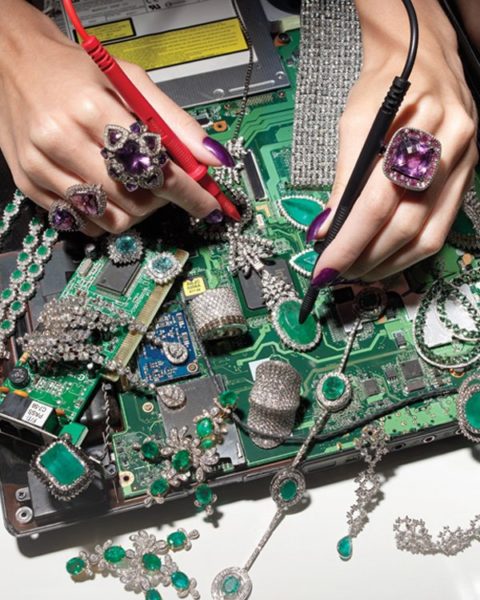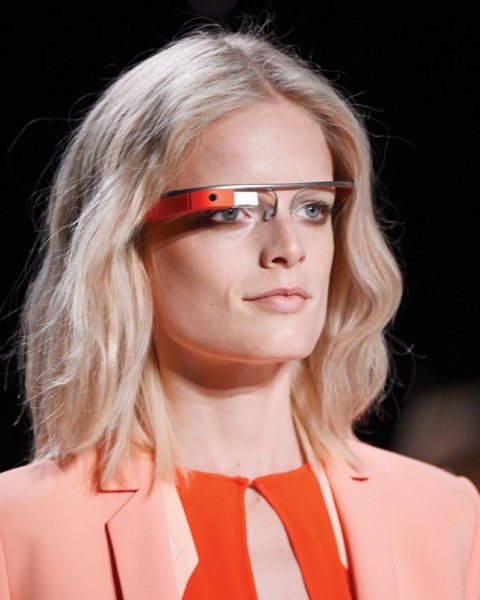Is wearable technology really the next big thing? We explore fashion’s whole new world


Fashion loves buzzwords. From arm party to It girl, these trendy terms infiltrate our minds, our Twitter feeds and our cocktail banter. Midway through the Spring 2015 collections during New York fashion week last September, there was a new bumper crop: artisanal, sock bootie, athleisure. But one in particular was light years ahead of them all: wearable technology. London-based interactive fashion brand CuteCircuit (Nicole Scherzinger wore its one-of-a-kind Twitter dress, which displays tweets in real time, on the red carpet in 2012) literally lit up the runway with its LED designs, which included tux jackets with illuminated lapels and miniskirts with electronic hearts. Models controlled their own outfits using a smartphone and an app.
State-of-the-art fashion continued its grand reveal at Rebecca Minkoff, where the designer teamed up with mobile accessories company Case-Mate on two unique pieces: a gold chain-link notification bracelet that buzzes (via Bluetooth) when you receive a call or text and a black leather band that charges your mobile device on the go. Wearables doubling as jewellery made several other guest appearances. At Opening Ceremony, we were introduced to MICA (My Intelligent Communication Accessory). The luxury bracelet, designed in collaboration with American tech giant Intel, features semi-precious stones and a 1.5-inch touch screen. Think sexy (18-karat gold and snakeskin) and smart (among its many tricks, it sends the wearer recommendations for local hotspots from Yelp). Diesel Black Gold hooked up with Samsung on its Gear S smart watch, which rocks the brand’s signature leather and metal details. Over in California that same week, Apple CEO Tim Cook unveiled Apple Watch, calling it the “most personal device we’ve ever created.” The tricked-out timepiece provides new ways to communicate right from your wrist, including transferring calls to your iPhone. Hello 007. It also features a Digital Crown—the first of its kind—which allows the wearer to scroll, zoom and navigate without covering the screen. This sleek design comes in an array of styles, including the super-luxe Edition, which boasts 18-karat yellow or rose gold. (You know it’s a fashion game-changer when Vogue editor-in-chief Anna Wintour attends the Parisian launch.) Clearly, sci-fi for the sartorially inclined is streaking toward Earth and heading straight for our jewellery boxes. In the ever-expanding galaxy of wearables, chic accessories are some of the brightest new stars.
“We’re used to carrying our technology with us, but now we want it to be part of us, part of our bodies,” says Tom Emrich, a Toronto-based tech consultant and founder of We Are Wearables, an organization that provides a hub for tech communities to explore and celebrate this emerging industry. When wearables started entering the mainstream in late 2012, no one was even saying the F-word—fashion. “The things we put on our bodies reflect our style and sense of self. There was a disconnect,” he says. Designers like Diane von Furstenberg and Tory Burch seized the opportunity, forming partnerships with companies such as Google and Fitbit, respectively. Wearables targeted to women rapidly shifted from geek to chic. Now, elegant fretwork pendants count calories, sleek timepieces answer calls and bejewelled rings keep us on schedule.

Christina Mercando knows a thing or two about good timing. The former senior product and design manager at eBay Inc. launched Ringly in 2013. Her line of 18-karat gold rings with precious and semi-precious stones syncs with phones and apps, vibrating to inform the wearer about important messages, calendar events and more. “I wear a lot of jewellery and I love gemstones,” she says. “I kept looking at my rings and thinking, ‘I’ve got to be able to put technology in here.’ Accessories are a natural fit because they have the space for components like batteries and sensors.” Working with a jewellery designer, she spent close to a year developing a prototype (and over six months on production) that would solve the problem of women being dependent on their phones while still staying connected and looking cool. “Most women don’t want to wear something that screams tech gadget,” she says. Needless to say, Ringly’s retailers are more Bloomingdale’s than Best Buy.
Given our society’s increasing demand for 24/7 accessibility, the idea of unplugging is tough to compute. Powering down may be considered prehistoric, but more and more designers are reinterpreting what it means to be disconnected. “We’re in a world now where we always have to have our phones with us. Rather than be inundated with information, we need devices that allow us to put our phones away and give our attention to whomever we’re with. And that device has to be beautiful,” says Walter Chefitz, former design director at David Yurman and co-founder of Viawear, a high-fashion wearable tech company based in San Francisco. Launching this spring, the Tyia notification bracelet blends fine jewellery with cutting-edge technology. After working on the piece for two years, he and his business partner Ben Isaacson debuted this screen-less star (it’s meant to keep you in the present without disruption).
“Tyia will notify you if it’s important,” says Chefitz. “Through your filters, you can set it up to allow only the most important calls through.” No sound is emitted; the technology lies in light and vibration. Of the latter, the wearer is able to control the pattern and intensity—a first in the wearables world. “If you have an appointment in 30 minutes, Tyia will let you know. Fifteen minutes later, the intensity of the vibration is twice what it was, so you really pay attention,” he says. Tyia has a sentimental side, too. She can use a heartbeat to alert you when a loved one is calling. As for her style, she’s very Jackie O-meets-The Jetsons. The classic leather wrap bracelet boasts 18-karat gold and semi-precious stones that have an RGB (red, green, blue) LED—similar to a television—behind them so they project over 200 different colours.
The gems are sourced from Idar-Oberstein in Germany, one of the world’s foremost gemstone towns. “We explored different semi-precious overlays and underlays and fused them together to make a single gem,” he says. “We found that semi-precious quartz on top of mother of pearl gives a moonstone effect. When you pass light through, it glows and looks like part of the gemstone.” With several designer collaborations set to launch later this year (like custom diamond-encrusted smart accessories), Tyia will be mingling with Hollywood’s finest in no time.

When it comes to wearables, blending in is the future. “Fashion is essential to move this technology into the background and make it invisible,” says Emrich. But these two worlds don’t always operate on the same trend cycle, especially when it comes to investment pieces. “Technology gets old and fashion is sometimes meant to be there forever,” he says. This is where modular technology comes into play. Smart accessories like Kairos’s T-band strap attach to almost any watch, including those timeless luxury tickers. “If I bought a Rolex, I could keep the face because the band is where all the connectivity and technology exists,” says Emrich. Watch collectors, you can exhale now.
This past January, the International Consumer Electronics Show in Las Vegas unveiled a number of new fash/tech collaborations, including Guess Connect (a chic smart watch that offers voice command functions and more) and Swarovski Shine (the collection features an activity-tracking faceted crystal, compatible with several accessories such as its sleek sport band and pendant). According to the Consumer Electronics Association, wearables will generate $5.1 billion in revenue in 2015—a 133 per cent jump from last year. Naysayers need only look at these numbers to realize wearables won’t end up as space junk.
We are living in a fully connected world, and now’s the time to dress for it. “This is the evolution of technology, the journey that we’ve been on since the computer,” says Emrich. “Wearable technology will almost make us superhuman.” With super closets. Suddenly Jane Jetson’s futuristic Christian Di-Orbit dress circa 2062 doesn’t seem so out of this world.







